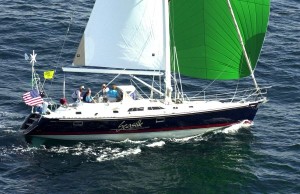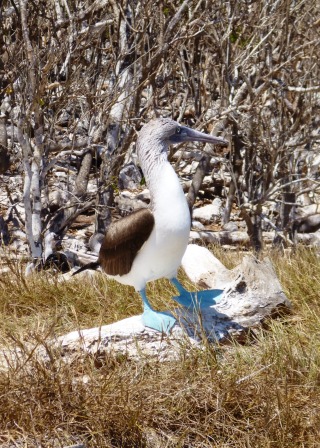Sailing the coast of Mexico
Sailing the coast of Mexico with friends

Who: Craig Blasingame & Sue Steven
Port: Coronado, California
27 April 2013 | Isla Partida
27 April 2013 | Candeleros Anchorage
13 April 2013 | San Juanico (not Calleta as Sue told the net this morning, lol)
11 April 2013 | Puerto Ballendra on Isla Carmen
05 April 2013 | Aqua Verde
03 April 2013 | San Francisco Island
30 March 2013 | La Paz
27 March 2013 | Isla Isabela
13 March 2013 | La Cruz
18 February 2013 | Barra Navidad, Grand Bay Hotel Marina
09 February 2013 | Zihuatanejo to Las Hadas
08 February 2013 | Zihuatanejo
07 February 2013 | Zihuatanejo
03 February 2013 | Zihuatanejo
28 January 2013 | Tenacatita
27 January 2013 | Tenacatita
26 January 2013 | Bahia Chamela, Isla Pasavera
25 January 2013 | Ipala
24 January 2013 | Yelapa
23 January 2013 | Mexico
On the road to the Sea of Cortez -- FINALLY!
27 March 2013 | Isla Isabela
Craig

If you've been following our blogs, then you know that the original plan was to spend the end of October and all of November 2012 in the Sea. That didn't happen, so the new plan is to go back as soon as the weather is nice enough. That would be about now, or at least by the time we get to La Paz, provision for a month and move north.
Along the way we are planning some fun and restful stops. The first of these is Isabela. Isabela is about 50 km north of Puerto Vallarta and is a Mexican bird preserve. Every time we have been to Isabela, there are researchers actively investigating the habits of the local inhabitants, primarily Blue-footed Boobies and Frigates. This time was no exception and we were once again able to go ashore and observe the antics of the local bird population up close. The boobie (no childish giggles here please) is a very striking bird. They have brown and white feathers and baby-blue feet. If it were not strange enough, having blue feet, they have a long thin beak with eyes set so far forward that they can look at you directly with both eyes at the same time. None of that moving your head side-to-side to get depth of vision for a boobie. They lay their eggs just above high tide on the beach on the rocks. Each nesting (if you can call laying an egg on the bare ground "nesting") pair seem to lay about 2 eggs about the size of a goose egg and the babies are fluffy white with spindly legs. The males are very protective. As you walk by the nest, the female will squawk at you in warning, but the male tries to lure you away from the area by flying from place to place. When not disturbed, the male will put on a show to let you know how proud he is that he's a new father. Strutting around with his blue feet doing a Nazi-style goose step, as if to say "look at this beautiful mate I have and the grand big egg she laid." Sometimes, if the egg has just been laid, you will see the female pecking at it as if to say, "holy cow, did that come out of me?"
If anything, Frigates are stranger looking than boobies. A large bird with a wing-span of up to 4 feet, the frigate lives in the air. Soaring high on the thermal currents, they are continually scanning for a meal. As a seabird, frigates are a bit of a failure since they cannot land on the water. That means that a fish meal must either be scooped up while flying just above the water, or more likely, stolen from another bird (like a pelican or a seagull) that can plunge into the water. Frigates are consummate thieves. Their nesting habits are more like birds as we think of it. They build a nest of twigs in the top of a low scrub bush or very top of a low tree and hatch one or two eggs. Their mating habits are less ordinary as the male frigate has this very large, bright red ballooning piece of skin that he inflates just under his beak to attract a female. Sue thinks it looks just like a bright red sailboat spinnaker sheet in full down-wind. She wonders if it is more effective, lol. Even from a distance out in the anchorage, the randy males' red bladders are visible with the naked eye.
Isabela is also a wonderful place to snorkel. Sue and I donned our wet suits (water is a chilly 62F) and went for a nice sunny snorkel around the many pinnacles and rocks covered in coral.
We leave Isabela tomorrow morning to cross the Gulf of California to Los Fralies. This is an overnight trip of about 30 hours and ends next to one of the best diving and snorkeling locations in Mexico...Cabo Pulmo National Underwater Reserve.
Along the way we are planning some fun and restful stops. The first of these is Isabela. Isabela is about 50 km north of Puerto Vallarta and is a Mexican bird preserve. Every time we have been to Isabela, there are researchers actively investigating the habits of the local inhabitants, primarily Blue-footed Boobies and Frigates. This time was no exception and we were once again able to go ashore and observe the antics of the local bird population up close. The boobie (no childish giggles here please) is a very striking bird. They have brown and white feathers and baby-blue feet. If it were not strange enough, having blue feet, they have a long thin beak with eyes set so far forward that they can look at you directly with both eyes at the same time. None of that moving your head side-to-side to get depth of vision for a boobie. They lay their eggs just above high tide on the beach on the rocks. Each nesting (if you can call laying an egg on the bare ground "nesting") pair seem to lay about 2 eggs about the size of a goose egg and the babies are fluffy white with spindly legs. The males are very protective. As you walk by the nest, the female will squawk at you in warning, but the male tries to lure you away from the area by flying from place to place. When not disturbed, the male will put on a show to let you know how proud he is that he's a new father. Strutting around with his blue feet doing a Nazi-style goose step, as if to say "look at this beautiful mate I have and the grand big egg she laid." Sometimes, if the egg has just been laid, you will see the female pecking at it as if to say, "holy cow, did that come out of me?"
If anything, Frigates are stranger looking than boobies. A large bird with a wing-span of up to 4 feet, the frigate lives in the air. Soaring high on the thermal currents, they are continually scanning for a meal. As a seabird, frigates are a bit of a failure since they cannot land on the water. That means that a fish meal must either be scooped up while flying just above the water, or more likely, stolen from another bird (like a pelican or a seagull) that can plunge into the water. Frigates are consummate thieves. Their nesting habits are more like birds as we think of it. They build a nest of twigs in the top of a low scrub bush or very top of a low tree and hatch one or two eggs. Their mating habits are less ordinary as the male frigate has this very large, bright red ballooning piece of skin that he inflates just under his beak to attract a female. Sue thinks it looks just like a bright red sailboat spinnaker sheet in full down-wind. She wonders if it is more effective, lol. Even from a distance out in the anchorage, the randy males' red bladders are visible with the naked eye.
Isabela is also a wonderful place to snorkel. Sue and I donned our wet suits (water is a chilly 62F) and went for a nice sunny snorkel around the many pinnacles and rocks covered in coral.
We leave Isabela tomorrow morning to cross the Gulf of California to Los Fralies. This is an overnight trip of about 30 hours and ends next to one of the best diving and snorkeling locations in Mexico...Cabo Pulmo National Underwater Reserve.
Comments
| Vessel Name: | SEASILK |
| Vessel Make/Model: | HYLAS 46 |
| Hailing Port: | Coronado, California |
| Crew: | Craig Blasingame & Sue Steven |
Gallery not available
Sailing the coast of Mexico with friends

Who: Craig Blasingame & Sue Steven
Port: Coronado, California